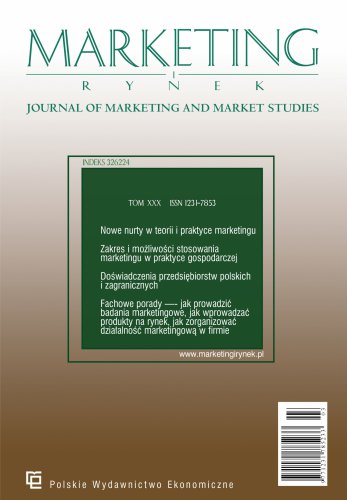Consumers' perception of holiday packaging and selected elements of their design based on the example of chocolate and chocolate product packaging
Packaging is a tool for effective communication with consumers and a way to influence consumer purchasing decisions. The coherence of the visual elements of the packaging, which is an important factor determining the choice of a given product, increases the chance of consumers making a purchase. Additionally, each element of the packaging, also called the mark of the visual layer of the packaging, provides the consumer with specific information, so the packaging is treated as an important carrier of encoded market messages. As a result, packaging that supports communication could significantly influence the consumer's choice of product. Packaging is also a tool of integrated marketing, and its task is to create the desired image of the product that will make the consumer decide to purchase it. Special examples of packaging that play an important role in market communication are packaging with holiday graphics: Easter and Christmas. The aim of the work is to analyse selected elements of the visual layer of packaging using eye-tracking methods, based on the verification of the level of consumer attention on packaging with classic and holiday graphics. The eye-tracking method allows to indicate which packaging arouses the greatest interest and is noticed most quickly by the consumer and allows to identify the areas that the examined person looks at. The added value of the method is the ability to verify the obtained test results with the declarations of the respondents.
References
Bibliografia/References
Ankiel-Homa, M. (2012). Wartość komunikacyjna opakowań jednostkowych. Wydawnictwo Uniwersytetu Ekonomicznego w Poznaniu.
Bergstromm J. R., & Schall A. J. (2014). Eye tracking in User Experience Design. Elsevier.
Bloch, P. H. (2011). Product design and marketing: Reflection after fifteen years. Journal of Product Innovation Management, 28(3). https://doi.org/10.1111/j.1540-5885.2011.00805.x
Butkevièiene, V., Stavinskiene, J., & Rutelione, A. (2008). Impact of consumer package communication on consumer decision making process. Engineering Economics, (1), 57–65.
Chandon, P., & Ordabayeva, N. (2009). Supersize in one dimension, downsize in three dimensions: Effects of spatial dimensionality on size perceptions and preferences. Journal of Marketing Research, 46(6). https://doi.org/10.1509/jmkr.46.6.739_JMR6C
Cholewa-Wójcik, A. (2016). Weryfikacja możliwości wykorzystania nieparametrycznego testu niezależności do analizy postrzegania wybranych elementów komunikacji wizualnej opakowań. Humanities and Social Sciences, XXI, (23/3), 9–21. https://doi.org/10.7862/rz.2016.hss.38
Cholewa-Wójcik, A., & Kawecka, A. (2015), The influence of effectiveness of packaging elements on consumers' preferences with the use of marketing eyetracking technique. Modern Management Review, XX(22/1). https://dpi.org/10.7862/rz.2015.mmr.4
Cholewa-Wójcik, A., & Świda, J. (2015). Perceptions of packages through the prism placed on them graphic elements – analysis using eye-tracking method. Opakowanie, 3.
Clement, J. (2007). Visual influence on in-store buying decisions: An eye-track experiment on visual influence of packaging design. Journal of Marketing Management, 23(9–10), 917–928. https://doi.org/10.1362/026725707X250395
Deng, X., & Srinivasan, R. (2013). When do transparent packages increase (or decrease) food consumption. Journal of Marketing, 77, 104–117. https://doi.org/10.1509/jm.11.0610
Duchowski, A. (2007). Eye Tracking Methodology. Theory and Practice (second edition). Springer.
Dziadkiewicz, A. (2019). Znaczenie designu opakowania w procesie podejmowania decyzji zakupowych przez konsumentów. Przedsiębiorczość – Edukacja, 15(2).
Garber, L., Hyat, E., & Boyna, U. (2009). The effect of package shape on apparent volume: An exploratory study with implication for package design. Journal of Marketing Theory and Practise, 17(3), 215–234. https://doi.org/10.2753/MTP1069-6679170302
Gulici-Zeko, D., Lutters, R., Klooster, T., & Weijzen, P. (2012). Studying the influence of packaging design on consumer perceptions (of dairy products) using categorizing and perceptual mapping. Packaging Technology and Science, 26(4). https://doi.org/10.1002/pts.1977
Husic-Mehmedovic, M., Omeragic, I., Batagelj, Z., & Kolar, T. (2017). Seeing is not necessarily liking: Advancing research on package design with eyetracking. Journal of Business Research, 80. https://doi.org/10.1016/j.jbusres.2017.04.019
Jerzyk, E. (2014). Design opakowania i jego elementy w procesie podejmowania decyzji zakupowych. Marketing i Rynek, (4).
Kabaja, B. (2021). Consumers' visual attention when choosing carbonated soft drinks – a study using eye-tracking methods. W: K. H. Soliman (red.), Innovation Management and Sustainable Economic Development in the Era of Global Pandemic: Proceedings of the 38th International Business Information Management Association Conference (IBIMA), 23–24 November 2021.
Kabaja, B., & Kozik, N. (2021). Przydatność metody eye-tracking do oceny percepcji warstwy wizualnej opakowań produktów przez konsumentów. W: A. Jaki, & B. Ziębicki (red.), Wiedza – gospodarka – społeczeństwo: wyzwania współczesnych organizacji i gospodarek. Instytut Nauk Ekonomicznych PAN, Uniwersytet Ekonomiczny w Krakowie.
Kotler, P., & Keller, K. L. (2013). Marketing, Rebis.
Kuvykaite, R., Dovaliene, A., & Navickiene, L. (2009). Impact of package elements on consumer's purchase decision. Economics & Management, 14.
Labrecque, L. I., & Milne, G. R. (2012). Exiting red and competent blue: the importance of color in marketing. Journal of the Academy of Marketing Science, 40(5). https://doi.org/10.1007/s11747-010-0245-y
Lisińska-Kuśnierz, M., & Ucherek, M. (2011). Essence of holistic angle on development of consumer behaviour by packaging. Towaroznawcze Problemy Jakości, (4).
Piłat-Borcuch, M. (2014). Socjologia designu. CeDeWu.
Piqueras-Fiszman, B., Velsaco, C., Salgado-Montejo, A., & Spence, C. (2013). Using combined eye tracking and word association in order to assess novel packaging solutions: A case study involving jam jars. Food Quality and Preference, 28(1). https://doi.org/10.1016/j.foodqual.2012.10.006
Rebollar, R., Lidon, I., Martin, J., & Puebla, M. (2015). The identification of viewing patterns of chocolate snack packages using eye-tracking techniques. Food Quality and Preference, 39, 251–258. https://doi.org/10.1016/j.foodqual.2014.08.002
Sielicka-Różyńska, M., Jerzyk, E., & Gluza, N. (2020). Consumer perception of packaging: An eye-tracking study of gluten-free cookies. International Journal of Consumer Studies, 23(1). https://doi.org/10.1111/ijcs.12600
Smoleń, K. (2023). Role of unit packaging visual layer in marketing activities. Modern Management Review, 29(2). https://doi.org/10.7862/rz.2023.mmr.13
Szymczak, J., & Ankiel-Homa, M. (2007). Opakowanie jednostkowe w działaniach marketingowych przedsiębiorstw. Wydawnictwo AE w Poznaniu.
Tonkin, C., Ouzts, A., & Duchowski, A. (2011). Eye tracking within the packaging design workflow: Interaction with physical and virtual shelves. NGCA'11, article no. 3.
Vilnai-Yavetz, I., & Koren, R. (2013). Cutting through the clutter: Purchase intentions as function of packaging instrumentality, aesthetics, and symbolism. The International Review of Retail, Distribution and Consumer Research, 23(4), 394–417. https://doi.org/10.1080/09593969.2013.792743
Wei, S. T., Ou, L. C., Luo, M. R., & Hutchings, J. B. (2014). Package design: Colour harmony and consumer expectations. International Journal of Design, 8(1).

